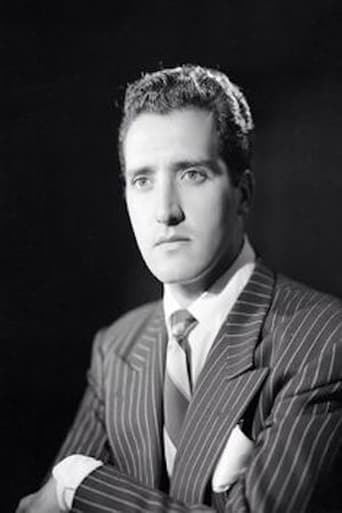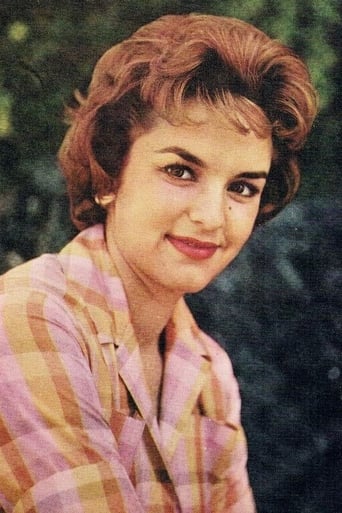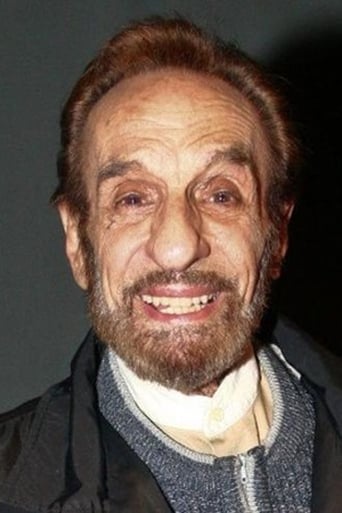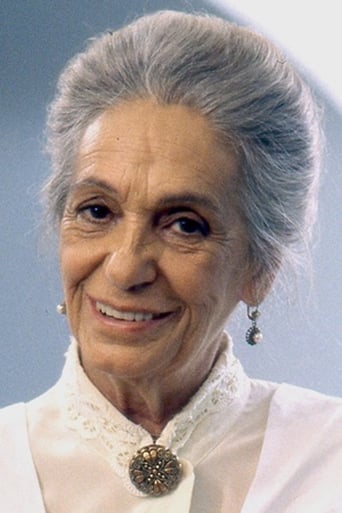Phonearl
Good start, but then it gets ruined
Zlatica
One of the worst ways to make a cult movie is to set out to make a cult movie.
Billy Ollie
Through painfully honest and emotional moments, the movie becomes irresistibly relatable
Allissa
.Like the great film, it's made with a great deal of visible affection both in front of and behind the camera.
MartinHafer
"The Vampire's Coffin" ("El Ataúd del Vampiro") is a bad horror film. However, it is not quite bad enough or silly enough for me to recommend it to bad movie buffs--though at times, it sure comes close!When the film began, I actually thought if might be a good film. It was very atmospheric and there was nothing to complain about...at least for a while. The Mexican horror filmmakers got the look right as grave robbers stole the coffin of Count Karol de Lavud (Germán Robles). It seems that an exceptionally stupid doctor wants the body to study HOW vampires are ageless. Perhaps, he thinks, he can learn the secret and use it on others. Not at all surprisingly, some butt-head ends up pulling the stake from the vampire's chest--and soon Count Lavud is alive and the butt-head is now the Count's slave. And, again not surprisingly, the Count goes on a killing spree until he is eventually destroyed (huzzah!).So why was this all so bad? Well, the most obvious problem is the worst use of strings I have ever seen in a vampire movie. Had the silly bat on a string been used sparingly, it might not have been that bad--but the stupid bat kept showing up and much of the end (inexplicably) has the hero battling the Count in bat form. Each and every time, the many strings holding the fake bat are VERY obvious. The same is true in a scene where you see a spear being tossed--you can see it suspended from strings! Now if I could easily see all this on a 42" TV, imagine seeing it on a big screen back in the 1950s!! And, speaking of spears, don't you think that if one of your big weaknesses as a vampire is a stake that you'd make sure your hideout does NOT have spears lying about as well as a cabinet full of spikes?! It's a lot like Superman keeping some Kryptonite in his fridge!! Apart from some dumb scenes, there also are some dull ones (such as some horribly choreographed and completely unnecessary dance numbers) and after the first 10 minutes I cannot recall anything good about the film!
ferbs54
In the ordinary course of things, a movie sequel begins production only after the original film has proved itself a success at the box office. This, however, was not the case with the sequel to the 1957 Mexican film "El Vampiro." Producer Abel Salazar, apparently, felt so confident that his film would be a hit--and it was; tremendously so--that he began work on that picture's follow-up even before the first one saw the light of day. That sequel, released in '58, was called "The Vampire's Coffin," and does what all good sequels should: expand on the story line and themes of the original, bring back characters from the first (four, in this case), and do its darnedest to top its predecessor. Like its more famous forebear, "The Vampire's Coffin," directed again by Fernando Mendez, must be deemed a complete success.When we last saw the Count Duval (played here again by Spanish émigré German Robles)--revealed to actually be the vampire Lavud--in the first film, he was lying in his coffin with a stake through his heart, courtesy of the elderly Aunt Maria (Alicia Montoya). The sequel picks up days, possibly weeks, later, when Aunt Maria unsuccessfully tries to stop a pair of crypt robbers from stealing the titular coffin. The casket is coincidentally brought to the very hospital where Dr. Enrique (whose actual name, we learn in this film, is Enrique Saldivar, played again by Abel himself), the hero of the first film, works, and where his current flame, showgirl Marta (Ariadna Welter, who played the damsel in distress in film #1), is for some strange reason helping him out. Trouble looms, however, when one of the tomb raiders, Barraza, removes the stake from Lavud's chest, reanimating the undead bloodsucker and commencing all the nastiness once again...."The Vampire's Coffin" has a very different feel than its original. Whereas that first film took place in the countryside, with an emphasis on its hacienda in the middle of nowhere, the sequel feels more urban, and transpires in what seems to be a small city. The main selling points of the first film--the remarkably dreary sets of Gunther Gerszo, the stunning B&W cinematography of Rosalio Solano, and those amazing, stationary mists--are largely absent in the second; though Gerszo also worked on the sequel, his sets here are more mundane, but fortunately, Victor Herrera's lensing is often quite remarkable. What this film can justifiably boast is some very impressive use of light and shadow, most especially in the scene where Lavud chases a young woman down a nighttime street. Still, the first film LOOKS better than the second; it is more artfully composed, with numerous scenes that you just want to freeze and admire. But the second film, if more prosaic, certainly moves quicker, and is more action oriented. Among the many exciting sequences is the one in which Aunt Maria tries to escape from Lavud and his hypnotized, thuggish henchman in a dreary wax museum, replete with fully functioning guillotine and iron maiden; the one where Enrique fights that same henchman, Barraza, on a high ladder perched atop a playhouse; and the wonderful finale, in the wax museum again, where Enrique fights it out with Lavud (as he had in the first film) whilst Maria lies nearby, in dire peril. Some truly exciting sequences in this follow-up, to be sure!Truth to tell, when I first watched the film in question, I was somewhat appalled at how stupid Enrique was acting. In several scenes, he voices the opinion that--despite everything he had witnessed in the first film--Lavud is not a genuine vampire, but merely a normal man who likes blood! Wha? How can any reasonable man be so naive? A repeat viewing, however, made me realize that Enrique was merely trying to cover up before his coworker, Dr. Mendoza (the other tomb raider), as well as dispel Marta's fears and concerns; Enrique redeemed, and all that. Abel, as usual (I have also seen him in such wonderful Mexican films as "The Brainiac," "The Man and the Monster" and "The Curse of the Crying Woman"), is a nicely ingratiating performer, and I was relieved to realize that his character had an ulterior motive for his seeming callowness. Still, Enrique does come off a bit goofier in this film, by dint of the picture's emphasis on amusing situations, such as Enrique being unable to explain to his hospital boss just HOW that coffin has disappeared, and his failed attempts to convince the police that there IS a vampire flapping about. Fortunately, the film never devolves into silliness, and the amusing bits are kept in check. One strange inconsistency that I did notice, in what is otherwise a seamless continuation of the original, is the matter of Lavud's reflectiveness in mirrors. In the first film, he is completely invisible in a mirror--as is Marta's vampiress Aunt Eloisa, too, for that matter--but here, he appears as a skeleton in a reflecting surface; only his skin is invisible. Don't ask me to explain; maybe it has something to do with being staked and coming back? But despite this possible glitch, and despite the film's aforementioned difference in tone and feel, "The Vampire's Coffin" remains a very fine sequel; a perfect double feature, natch, when viewed following the original. And thanks to the good folks at Casa Negra, both films are currently available on great-looking, extras-packed DVDs. Not for the first time, thus, am I being compelled to say, with gratitude, "Gracias, Casa Negra!"
Scarecrow-88
When a colleague of his unearths the coffin of a vampire, Dr. Enrique Saldívar(Abel Salazar)finds his life turned upside down as the one who helped bring the corpse(..with the stake still plunged into his heart), a criminal fiend, Baraza(a brutish Yerye Beirute;perhaps not used as much as he should have been)desires for the amulet around Count Karol de Duvall's(Germán Robles)neck. In getting to the amulet, Baraza has to remove the stake lunged in the Count's heart and when he does, the vampire has free access to once again bite the necks of females for blood. As obvious in these films, the Count will command(by using the amulet, a hypnotic device he uses to control his victims)Baraza to do his bidding..especially as a watchman when he sleeps during the day. Duvall sets his sights on theater actress Marta González(Ariadna Welter), Saldívar's love-interest, desiring to make her his vampire bride. María Teresa(Alicia Montoya)knows all too well what Duvall is capable of as she's been guardian over his tomb for some time and had tried to stop Saldívar's colleague(a doctor wishing to study the cellular structure of a vampire as part of researching diseases of the blood)and Baraza from removing his coffin from it's place of rest. When Baraza and Duvall flee from the Pasteur medical clinic where the coffin was taken(..not before Duvall casts a spell on Marta and almost chomps down on a little girl's neck), Saldívar will have to somehow protect Marta against a predator he's ill-prepared for. We see that María and Saldívar's colleague face a horrifying fate when they seek to find the vampire and his coffin..in a wax museum featuring "devices of death" where in the basement both can be found. It all comes to head when the Count and his henchmen seek to kidnap Marta during a stage production as Saldívar must follow them into their wax museum lair for the ultimate stand-off.Although the flick suffers from some embarrassing bat sequences where you can clearly see the strings controlling it, this is quite an entertaining modern Gothic vampire tale. It's your typical Mexican horror flick incorporating borrowed elements, such as the wax museum which I thought was a marvelous hiding spot for the vampire, but takes some interesting liberties such as having the Count disappear and reappear often tricking those who both know and not know he's in the building(..or room)with them. The amulet around the Count's neck is a major device he uses to control people where oftentimes a vampire can merely focus his eyes on the victim. There's an inspired sequence where an unfortunate victim finds her way into an iron maiden in the wax museum as she is trying to hide from Baraza. The one problem, besides the bat's visible strings, is the fact that Count Duvall is too much of a pushover against Saldívar. He's able to fight him a bit too easily while struggling mightily against Baraza. The chief plus of the picture is the Gothic atmosphere and lighting in a modern setting. There's a great scene where the Count opens his cape as the shadow nearly engulfs the whole picture as he pursues a victim into an alley-way. The Count's demise at the end is kind of neat and different than in a lot of vampire flicks in that he's actually in bat form when suffering a grim fate.
MARIO GAUCI
Mondo Macabro's R2 DVD of this film's prequel, THE VAMPIRE (1957), had included stills from the follow-up excerpted from its photo-novel edition (apparently included in full as a DVD-ROM extra on Casa Negra's 2-Disc R1 Set "The Vampire Collection"); at the time, the synopsis had felt contrived and, therefore, I had anticipated that the film itself would be inferior to the original (though I'm still disappointed that there's no Audio Commentary to accompany it!). Having watched THE VAMPIRE'S COFFIN now - and re-acquainted myself with its predecessor (the very first Mexican horror effort I'd seen), which didn't disappoint - I can only confirm this! Anyway, the original was largely set at a dilapidated hacienda in a remote village - with characters dressed in old-style clothing and an overpowering foggy atmosphere - so that it was jarring to see these same characters (or who was left standing among them) transposed to modern city surroundings! Apparently, the film-makers purposely opted to make the sequel as different as possible to its predecessor - and, while that same Gothic mood is felt on occasion, the three main settings of the film, i.e. hospital, wax museum and burlesque theater, elicit their own particular ambiance with which the vampire character may not always be compatible (for instance, he appears outside a bar to stalk an aspiring young female performer incongruously dressed in his traditional cape...and, yet, she never for a moment suspects his true intentions, in fact welcomes the stranger's advances by throwing flirtatious glances at him herself)! The music score is typically overstated (as far as I can tell replicating that of the original, where it seemed to work better!) and the special effects pretty ropey - especially the very visible wires holding the supposedly flying bat, but also the number of times that the vampire is seen reflected in a mirror when it's made clear that he shouldn't!; that said, the transition from vampire to bat is, once again, neatly enough done. The most atmospheric moments are those set in the wax museum with its numerous torture devices (though the climax is a rather awkward mess!), and the large shadows thrown by the vampire on the various buildings in the afore-mentioned stalking sequence (in fact, the film-makers seem to have liked this effect so much that the scene is absurdly extended, when the vampire could very easily have rendered himself invisible at any moment and let the girl simply fall into his clutches - as he does, eventually!). Resting largely on the shoulders of lead/producer Abel Salazar, the comic relief comes off remarkably well (particularly in scenes where he has to explain his tall tale about disappearing coffins and rampaging vampires to his superiors or the police) and, in fact, my relative disappointment with the film isn't due to any intrinsic campiness - as was the case with THE BRAINIAC (1962), for instance - though, as per reviews I've read of the English-dubbed U.S. version prepared by K. Gordon Murray (included on the DVD but which I haven't checked out), it's a different matter altogether! As for the principal cast members, Salazar is, again, an engaging hero; likewise, Ariadne Welter is lovely throughout (even when engaged in a sleazy dance number!) - but German Robles fares less well than in the first film (where he had cut a suitably imposing figure), here tending to come off as merely nonchalant...and a veritable Elvis Costello look-alike to boot! The evidently rushed production, then, ultimately brings (perhaps unkind) comparisons - with respect to the difference in quality between the two films - to SON OF KONG (1933) when stacked up against its monumental prequel!





